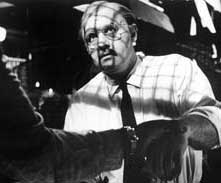Artistically and thematically, Sidney Lumet’s The Pawnbroker is a significant film–it is one of the first Hollywood movies to deal with the Holocaust and its aftermath.
| The Pawnbroker | |
|---|---|

Theatrical release poster
|
|
Rod Steiger plays Sol Nazerman, a middle-aged survivor of Nazi persecution, who had lost his entire family and now runs a pawnshop in Harlem. That he has remained alive is a source of bewilderment, guilt, and pain. Having lost faith in God and humanity, Sol is emotionless and totally removed from the world that surrounds his run-down shop.
All of Sol’s present encounters are shaped by his anguished past, beginning with his assistant Jesus Ortiz (Jaime Sanchez).
The kind and patient social worker Marilyn Birchfield (Geraldine Fitzgerald) tries to get through Sol’s icy exterior but to no avail.
Indeed, when his father-in-law dies, he offers his wife no sympathy.
Initially, the more people try to reach out to Sol, the more he becomes cruel and offensive to them. Hence, efforts by Jesus (note the symbolic name) to learn the trade from his boss Sol result in violent outbursts.
Sol is involved in a peculiar affair with Tessie (Marketta Kimbrell), a fellow camp survivor whose husband was a victim of Nazi atrocities. However, their torment seems to be the only thing that keeps them together.
Spoiler Alert: Last Reel
During the robbery by Tangee’s gang, Nazerman refuses to hand over his money. A member of the gang pulls a gun and, in trying to save Nazerman, Ortiz is shot. The gang flees and Ortiz drags himself out onto the street. Nazerman stumbles out of his shop and silently sobs while Ortiz dies. Ortiz’s body is taken away by ambulance and Nazerman goes back inside. He impales his hand on a receipt spike before wandering away from the shop.
Lumet directs the movie in a gritty, raw style that was fashionable at the time, a byproduct of the French New Wave and its huge impact on world cinema.
To represent the disturbing, unrelenting flashes of Sol’s memory, “The Pawnbroker” uses flashbacks in an innovative way: Ace lenser Boris Kaufman presents as black-and-white quick cuts that last only a fraction of a second.
At the time, some critics had reservations about the jazzy score of the young Quincy Jones, an element that also borrowed from early works of the New Wave, such as Louis Malle’s “Elevator to the Gallows.”
The script of David Friedkin and Morton Fine departs from Edward Lewis Wallant’s novel upon which it is based. For example, the details of medical experiments upon Sol (and others) by the ruthless Nazi administration have been removed from the movie.
Rising to the occasion, Rod Steiger renders a towering, Oscar-nominated performance as the volatile survivor, a powder keg of hateful remembrances, who has become detached and remote in the modern world. He embodies the ageless wondering Jew, the lonely outcast, who can’t adjust to normal life.
Dark and haunting, “The Pawnbroker” is an urban tragedy of God’s lonely man, who has eschewed involvement and compassion. Living a barren, rootless life, he is in desperate need for redemption.
Cast:
Sol Nazerman (Rod Steiger)
Marilyn Birchfield (Geraldine Fitzgerald)
Jesus Ortiz (Jaime Sanchez)
Rodriguez (Brock Peters)
Ortiz’s Girl (Thelma Oliver)
Tessie (Marketa Kimbrel)
Mendel (Baruch Lumet)
Mr. Smith (Juano Hernandez)
Ruth Mazerman (Linda Geiser)
Bertha (Nancy R. Pollock)
Credits:
Running Time: 114 minutes
American International Release
Eli Landau/Ungar Production
Produced by Roger Lewis and Philip Langner
Directed by Sidney Lumet
Screenplay: David Friedkin and Morton Fine, based on the novel by Edward Lewis Wallant
Camera: Boris Kaufman
Editor: Ralph Rosenblum
Music: Quincy Jones
Art director: Richard Sylbert
Costume: Anna Hill Johnstone
Oscar Alert
In 1965, Rod Steiger competed for the Best Actor Oscar with Richard Burton in “The Spy Who Came in from the Cold,” Lee Marvin (who won) in “Cat Ballou,” Laurence Olivier in “Othello,” and Oskar Werner in “Ship of Fools.” Steiger would win the Best Actor Oscar in 1967 for “In the Heat of the Night.”











